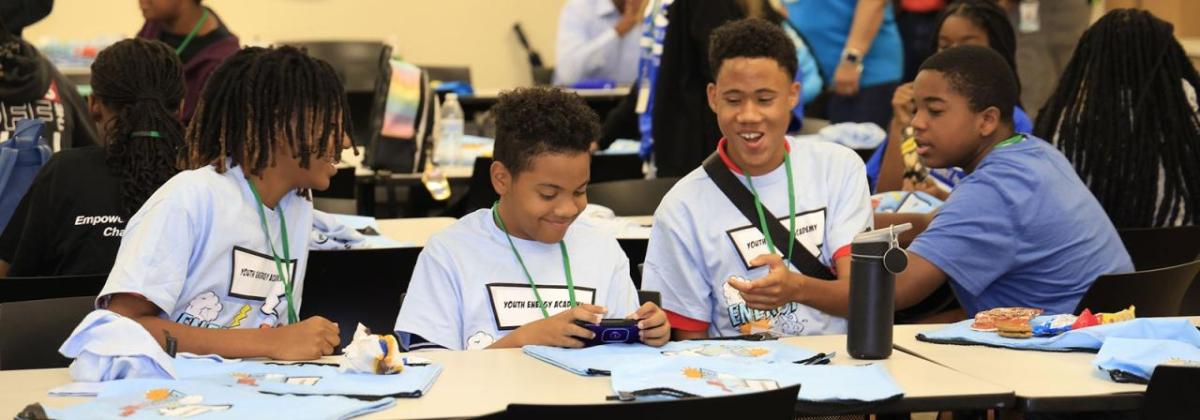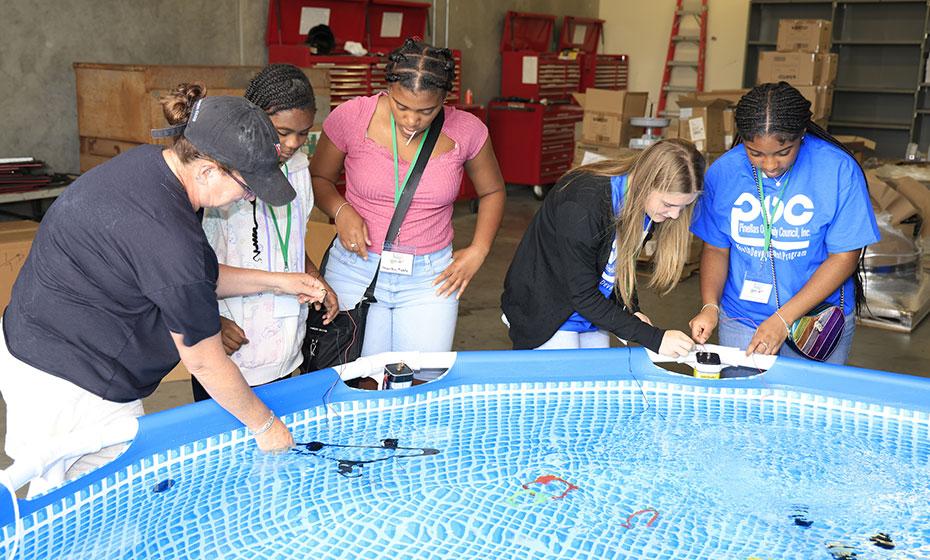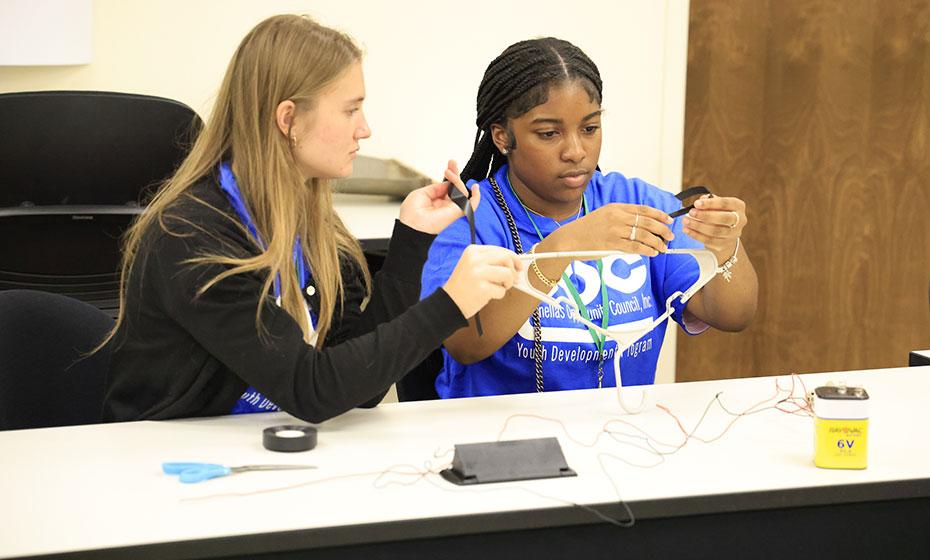Working With Youth To Spark Interest in Energy Careers
Youth Energy Academy proactively gains the interest of an emerging workforce by educating students about viable, good-paying jobs
By Page Leggett | illumination Contributor
Unless students have a family member who works at a utility, they may not think of Duke Energy as a viable career path. It’s the sort of thing that motivates Melvin Philpot – both in his 43 years at the company and in his role as community outreach committee chair for the American Association of Black Engineers’ (AABE) Florida chapter.
“When middle schoolers walk down their streets and see lineworkers atop utility poles, we want them to think of the energy industry for potentially high-earnings jobs,” said Philpot, products and services manager in Lake Mary, Fla.
More than a decade ago, Philpot attended an AABE-sponsored youth career forum with Duke Energy Managing Director Malcolm Barnes; they liked the idea of introducing students from diverse neighborhoods to viable, good-paying jobs in the energy sector and wondered if Duke Energy could offer something similar.
Michael Lewis, then-EVP of a Duke Energy predecessor company, encouraged them to add a craft and technical component to the curriculum for students who may not be college-bound. And with a $2,000 donation from AABE to help launch the new initiative, the Youth Energy Academy – YEA, for short – was born.
Through hands-on activities and live demonstrations, YEA proactively gains the interest of an emerging workforce by educating young people about the opportunities that exist. The annual career readiness program also aims to advance diversity, equity and inclusion within the energy sector and related STEM fields by engaging eighth through 12th graders who may not have the same opportunities as other students.
“When you’re 15 and 16, you’re sort of looking for someone to tell you what the future holds. That’s where we come in,” said Chiquita Clark, supervisor of South Coastal Work Management at Duke Energy’s Clearwater Operations Center. “We can turn to our community’s youth and say: We’re people who look like you. Let us show you what we do, and if it looks interesting, we can help get you here.”
So many career paths
Clark, a member of AABE Florida, helped plan the 2024 St. Pete Youth Energy Academy, hosted at a Duke Energy power plant in Bartow, Fla. Close to 60 students – the maximum – attended the two-day event.
They heard, by video, from Erin Jackson, a former STEM student and speed skater from Ocala, Fla., who competed in the 2022 Beijing Winter Olympics. Jackson is a former AABE scholarship recipient who became the first Black woman to win a Winter Olympic gold in an individual sport in 2022; before that, she earned an engineering degree from the University of Florida.
Other sessions included a plant tour, “A Day as a Line Tech” workshop, an electric vehicle (EV) demonstration and a career panel that brought together a diverse group of employees at all stages of their careers.
The power of partnerships
YEA started small; the first academy attracted eight students. Vice President of Operations Dave Maxon encouraged Duke Energy’s African American employee resource group (ERG) to help develop the concept. Then Mikel Gordon, supervisor for energy efficiency services, joined the effort.
Bringing in partners to provide financial or in-kind support has helped YEA expand. Duke Energy and other neighboring utilities have signed on to help, as have community colleges, schools and nonprofits across the state.
Now it’s grown geographically to include six regions, including Ocala and Tallahassee. Three years ago, an academy was started in Lake Wales, Fla., at the majority Hispanic McLaughlin Academy of Excellence – the only remaining public middle school in Polk County.
“YEA would not have grown as it has – or been as successful – without its primary funder,” Philpot said. “And that’s the Duke Energy Foundation.”
Since 2016, Duke Energy and its Foundation have provided over $120,000 to AABE to support the academy.
‘Their goals are attainable’
At St. Petersburg College (SPC) – another YEA partner – more than 115 students in eighth through 12th grades have expressed an interest in STEM careers. Most are from underserved or low-income neighborhoods and are part of the College Reach Out Program (CROP), which aims to show these students they are college material, said Program Coordinator Keisha Blue.
That message is reinforced for CROP students who attend the academy. “Our students are meeting people who look like them,” Blue said. “They see themselves reflected back – and they get to see that their goals are attainable.”
Nearly all high school students who participate in CROP will graduate from high school, Blue said, and many will enroll at SPC.
"We’re dedicated to staying at the forefront of technology,” said Professor Chad Mairn, founder of SPC’s Innovation Lab. “We introduce artificial intelligence, virtual and augmented reality, cybersecurity and many other emerging technologies to support and enhance the curriculum, which is relevant to contemporary STEM careers but also anticipates and prepares students for careers of the future – even careers that may not exist yet.”
It’s what you know and who you know
Some of the jobs YEA students may land after high school or college are unheard of now. Virtual reality developers, drone operators and sustainability managers didn’t exist a decade or so ago, and all are in demand today.
Bottom line: Students need to be ready for the STEM jobs that have yet to be created. And they need teachers, mentors, role models.
Philpot knows that mentors matter. As one of seven siblings from a single-parent family, he was going to work on railroad cars until a counselor encouraged him to go to community college. He earned his degree at night while working in customer service – “the one job that gives you a full view of the entire company.
“Working on the Youth Energy Academy has been gratifying because, I guess, I’ve helped to plant some seeds and be an ambassador for a great company,” Philpot said.
Clark, too, likes promoting Duke Energy. She joined the company as a contractor in 2014 and as a full-timer the following year. “From the beginning, it’s been like a big family,” she said. “The company is invested in developing employees. All you really have to do is have a desire to succeed.”
The department you start in, she’ll often tell students, doesn’t have to be the department you stay in.
“At Duke Energy, you can start as an admin or office manager and progress to a community relations manager,” she said. “We want students to understand just how many options they have here.”
When these students see a diverse workforce – and a diverse leadership team – they realize there’s a place for them at Duke Energy, too. Perhaps as a lineworker.
But not necessarily.
“Many students assume a Duke Energy career refers only to lineworkers,” Clark said. “And while we do talk about their indispensable work, we also showcase engineers, arborists, chemists, drone operators, helicopter pilots, the corporate communications team. While lineworkers play an essential role in keeping the lights on, there are so many other functions that help ensure our customers are served and our communities are thriving.”
View original content here.





